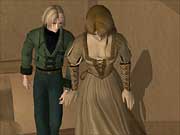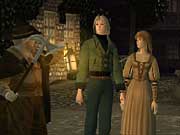Shadow of Destiny was originally released for the PlayStation 2 in Japan last year, and it was later localized for US PlayStation 2 owners with full English speech. Still, it seems much better suited to the PC adventure game genre. It has all the necessary components: a hapless protagonist investigating a mystery, inventory-based puzzles, a moderately complex story that unfolds over the course of the game, and no standard way for your character to permanently die (though there are a few ways to lose the game outright). Shadow of Destiny tells the story of Eike (pronounced "Ike"), a student who is murdered without warning while wandering the streets of his hometown one day and is then brought back to life by an enigmatic spirit who gives him the ability to travel through time. Eike must use this ability to visit four different time periods in a quest to prevent his own murder and uncover the motives of his mysterious assailant.

Unfortunately, Shadow of Destiny's roots as a Japanese PlayStation 2 game are rather obvious. On one hand, the game uses the same sort of detailed, high-polygon character models that have become so fashionable in character-driven Japanese console role-playing games. They've been optimized to work at higher resolutions, and though they'll sometimes have some pretty obvious jagged edges in the game's cinematic close-ups, all the characters look quite good and have detailed facial animations. On the other hand, the game's environments look quite bad. Eike spends most of the game in different time periods in the same town, but no matter when he visits, the town, its buildings, and its scenery always look blocky and plain--even crude at times.
Shadow of Destiny also sounds like a PlayStation 2 port of a Japanese game. If you've been playing games for a while, you know by now that when Japanese games get dubbed in English, the English versions often have terrible voice acting. This isn't entirely true for Shadow of Destiny--it does have the same sort of occasionally clumsy translation and the same kind of awkward voice acting you may have come to expect from dubbed Japanese video games or movies, but much of it is actually decent, and it's delivered enthusiastically. The same can't be said for the game's generally subdued soundtrack, which features a few decent symphonic tunes during the game's in-engine cutscenes but is generally quiet and difficult to even notice while you're actually playing the game.
As for the actual game, Shadow of Destiny is so much like a conventional graphical adventure like Grim Fandango or The Longest Journey that it may surprise you. Though the game's generally easy-to-use interface was clearly designed for the PlayStation 2 controller, it also works quite well with the arrow keys and the mouse. About the only time you'll encounter camera problems is when Eike enters buildings and can't freely look around--you'll sometimes have trouble getting to the right door or finding your way around because part of a wall or ceiling will be blocking your view. Beyond that, playing Shadow of Destiny is all about talking to the right people and using the right inventory items at the right time. Though the game does have some obtuse puzzles--like rescuing a helpless person in exchange for a bauble, which you then trade for a frying pan that you place down the back of your jacket to prevent getting stabbed--many of Shadow of Destiny's puzzles actually make sense.

More importantly, the game's interesting story does a good job of giving these puzzles real context and giving you real motivation to solve them--if you don't, Eike will never be free of the never-ending cycle of getting killed and then returning to the past just before the time of his death. The issue of time travel is handled extremely well in the game, as the actions you take in the past will have real effects in the future. For instance, in one scene, Eike is murdered by an assailant hiding in a huge tree. Armed with that knowledge, on his next try, he can travel back in time and make sure the tree was never planted. Shadow of Destiny actually has four different endings that will change depending on how much of the mystery you manage to unravel and your actions while traveling through time, and these additional endings add replay value to the game.
It's unfortunate, but graphical adventure games, which used to be the most popular kind of computer game around, have been in decline for some years. As such, it may seem ironic that Shadow of Destiny, one of the best PC adventure games to come around in some time, was originally a console game. Then again, most fans of adventure games will likely ignore the irony at this point and just be glad to get their hands on a decent one for their PCs.